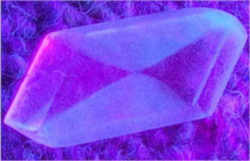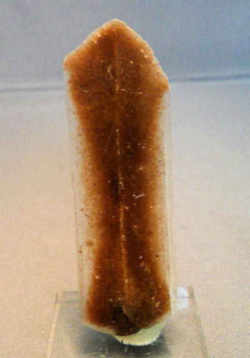
Oklahoma Symbols
Oklahoma State Crystal
Hourglass Selenite Crystal

Adopted in 2005.
The Hourglass Selenite Crystal was adopted in 2005 as Oklahoma's State Crystal.
These crystals are found only on the salt plains of Oklahoma, a unique 11,000-acre geological area. The salt plains were formed by repeated flooding by sea water millions of years ago. On the salt plains, sand and clay particles often form an "hourglass" shape inside the crystal. Crystals measuring up to 7 inches long have been found, along with complex combinations weighing as much as 38 pounds.
Oklahoma State Crystal: Hourglass Selenite Crystal
History of Adoption
A group of Oklahoma school children thought it was high time one of the state's naturally occurring gems got official recognition- and State Senator Kathleen Wilcoxson worked to make sure the gem and the students had a chance to shine. She's filed legislation to make Selenite Crystal the state's official gemstone.
The proposal came to Sen. Wilcoxson from 105 students in the third through sixth grade at Bryant and Red Oak schools. The students are part of the
Moore School District's Gifted and Talented program known as S.E.A.R.C.H., which stands for "Students Experiencing Appropriate Research and Creative
Happenings."
"I am so impressed with these children. They had done their research and found that 15 states already have an official gemstone. They proposed Selenite
Crystal of Oklahoma's Great Salt Plains to be Oklahoma's official gemstone because of its unique characteristics," said Wilcoxson, R-OKC.
Selenite crystals are formed just under a wafer thin salt crust found on a portion of the salt flats. Ground water travels through the salt-saturated sand and comes to the surface where it evaporates, leaving the crust of salt. The concentrated saline solution combines with gypsum to promote selenite crystal growth. Because these crystals form in wet soil, sand and clay particles are included within the crystal. These particles often form an "hourglass" shape, found only at the Salt Plains. According to the US Fish and Wildlife Service, iron oxide in the soil gives the crystals their reddish to chocolate brown color.
Sen. David Myers, R-Ponca City, will serve as co-author of the measure. Rep. Paul Wesselhoft, R-Moore and Rep. Jeff Hickman, R-Woodward will serve
as House authors.
"What an incredible lesson for these students. They've learned about geology, geography, research and state government. I'm hopeful they'll be able
to see their proposal make it all the way to the Governor's desk during the 2005 legislative session," Wilcoxson said.
The 2005 session formally got underway on February 7, and SB 4 by Sen. Kathleen Wilcoxson and Rep. Paul Wesselhoft makes hourglass selenite crystal
the official state crystal. The bill in emergency session passed 92-3.
Selenite Crystals

The salt was formed by the repeated
flooding of seawater millions of years ago. The seawater was eventually cut off and evaporated, depositing thick layers of salt and subsequently covered
by erosion from surrounding mountain ranges. For millions of years, below the plains the groundwater has continued to travel through the salt-saturated
sand and rises to the surface and evaporates, leaving a thin crust of salt. It is the concentrated saline solution combining with the gypsum that promotes
the selenite crystal growth in a portion of the salt flats.
Selenite is a crystallized form of gypsum. Chemically, it is a hydrous calcium sulfate. Gypsum is a common mineral that takes on a great variety of
crystal forms and shapes. On the Salt Plains, the crystals are formed just below the salt encrusted surface. They are seldom found deeper than two
feet below the surface.
Crystals take on the characteristics of their environment - the finer the soil, the more clear the crystals. It is the iron oxide in the soil that
gives the crystals their chocolate brown color.
What is So Special About These Crystals?
Because these crystals form in wet soil, sand and clay particles are included within the crystal. These particles often form an "hourglass"
shape inside the crystal. This hourglass shape is not found in selenite crystals anywhere else in the world - it is only found here on the Salt Plains
of northwest Oklahoma.
Single crystal blades, penetration twins, and clusters are the typical crystal shapes most frequently encountered on the refuge. Exceptional individual
crystals measuring up to seven inches long have been found, along with complex combinations weighing as much as 38 pounds. In certain places on the
Salt Plains, gypsum and saline solutions in the soil are sufficiently concentrated to promote crystal growth. When temperature and brine conditions
are ideal, the crystals may form very rapidly. When heavy rains or floods bring great quantities of freshwater to the plains, some of the selenite
crystals may go back into solution until conditions are right for recrystallization.
Oklahoma Law
The law designating the hourglass selenite crystal as the official Oklahoma state crystal is found in the Oklahoma Statutes, Title 25, Section 25-98.8.
Title 25. Definitions and General Provisions
Section 25.98.8
The hourglass selenite crystal is hereby designated and adopted as the official crystal of the State of Oklahoma.
Added by Laws 2005, c. 14, § 1, emerg. eff. April 1, 2005.







